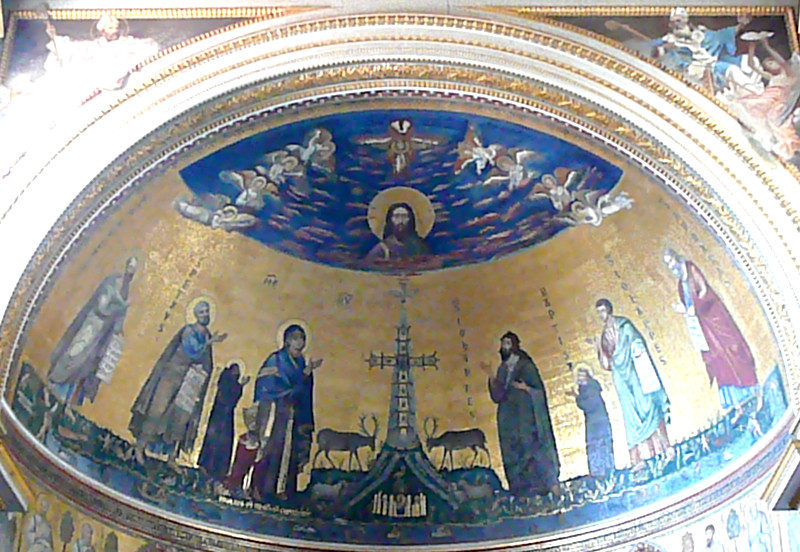The Apse Mosaic at the Basilica of St. John Lateran

4th or 5th century (Christ with angels, cross with stags and rivers, river border)
6th century (the six tall saints flanking the Cross)
13th century (repairs and addition of Nicholas IV and SS. Francis and Anthony)
Basilica of St. John Lateran, Rome
The mosaic is actually a Crucifixion image, with the historical crucifixion represented in the small medallion at the center of the cross and the rest a meditation on the timeless meaning of that event.
In this work, the cross is Christ. Like Christ in the Deësis it is flanked by Mary and John the Baptist. Four of the other saints who flank it carry scrolls attesting to Christ's divinity. From it flow the streams of water from which the stags are drinking, an allusion to Ps. 42:1, "As the hart panteth after the fountains of water; so my soul panteth after thee, O God."
Most importantly, the flowing streams and the vibrant river life at the bottom of the image (see detail) refer to Ezekiel 47, which is read in Roman Catholic churches each year on the Feast of the Dedication of the Lateran Basilica (November 8). In this chapter Ezekiel is given a vision of streams flowing out from the Temple to all the land, making it fertile and healing even the salt sea: "There shall be fishes in abundance...and all things shall live to which the torrent shall come.... And by the torrent on the banks thereof on both sides shall grow all trees that bear fruit...and their fruit shall not fail (9, 12)." In traditional Christian interpretation, the Temple of this vision is Christ, and the water is the water of baptism. Thus the mosaic labels the river as IORDANES, the Jordan, symbol of Christian baptism.
The central meaning, then, is that the cross of Christ fulfills the promise of salvation made to Ezekiel, restoring mankind and indeed all of nature to God's grace. We are again in Eden, as is also suggested by the fact that there are four streams, like the four rivers flowing from Eden in Genesis 2:10-14. This restoration is also suggested by the Tree of Life between the streams, with a phoenix perched in it, and by the New Jerusalem directly below. It is a theme is especially suited to St. John Lateran, which was originally called the Basilica of the Savior.
The figures in the mosaic are identified by labels. On the left (see detail) are St. Paul, St. Peter, St. Francis of Assisi, and a smaller figure of Pope Nicholas IV, who ordered the 13th century work. The Virgin places her right hand on his tiara. The scroll in St. Paul's hand has the words salvatorem expectantes, apparently from Titus 2:13, which in full reads expectantes beatam spem et adventum gloriae magni Dei et salvatoris nostri Iesu Christi, "Looking for the blessed hope and coming of the glory of the great God and our savior Jesus Christ." St. Peter's scroll bears the words he spoke to Jesus in Matthew 16:16, tu es christus filius dei vivi, "you are the Christ, the son of the living God."
On the right (see detail) are St. John the Baptist, a smaller figure of St. Anthony of Padua (1195-1231), St. John the Evangelist, and St. Andrew. The Evangelist's scroll reads in principio erat verbum, the first words of his gospel ("In the beginning was the Word"). I have not been able to identify the words on Andrew's scroll, but they begin with tu es, "thou art" – it was Andrew who first suggested to Peter that Jesus was the Messiah.
It should be no surprise that Camerino and Torriti included St. Francis and his follower St. Anthony, because these artists were themselves Franciscan friars, and Nicholas their patron was the first Franciscan Pope.
According to the Catholic Encyclopedia (s.v. "Saint John Lateran"), the figure of Christ with the angels is from the 5th century, possibly the 4th. Also from this period are the Cross in the center, the four rivers flowing from it, and the river scene along the bottom. The saints standing on either side of the Cross are from the 6th century; they were repaired in the 13th by Pope Nicholas IV, who is shown prostrate at the feet of the Virgin Mary. Also from the 13th are the figures of St. Francis and St. Anthony of Padua, who have been shoehorned in to the left of Mary and the right of St. John.
Details from the image:
Photographed at the basilica by Richard Stracke, shared under Attribution-NonCommercial-ShareAlike license.